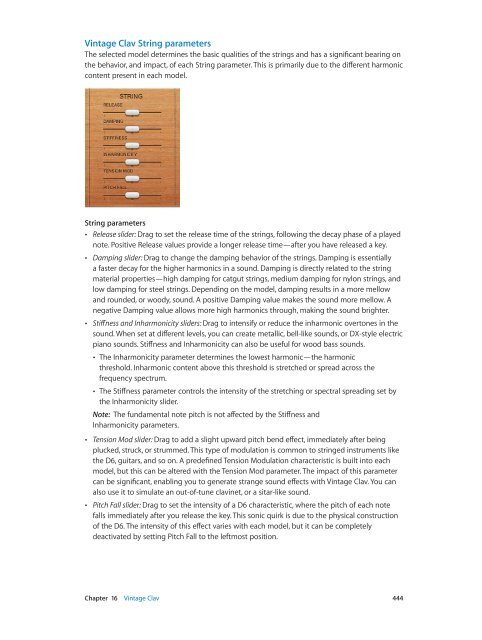Apple MainStage 3 Instruments - MainStage 3 Instruments
Apple MainStage 3 Instruments - MainStage 3 Instruments
Apple MainStage 3 Instruments - MainStage 3 Instruments
You also want an ePaper? Increase the reach of your titles
YUMPU automatically turns print PDFs into web optimized ePapers that Google loves.
Vintage Clav String parameters<br />
The selected model determines the basic qualities of the strings and has a significant bearing on<br />
the behavior, and impact, of each String parameter. This is primarily due to the different harmonic<br />
content present in each model.<br />
String parameters<br />
••<br />
Release slider: Drag to set the release time of the strings, following the decay phase of a played<br />
note. Positive Release values provide a longer release time—after you have released a key.<br />
••<br />
Damping slider: Drag to change the damping behavior of the strings. Damping is essentially<br />
a faster decay for the higher harmonics in a sound. Damping is directly related to the string<br />
material properties—high damping for catgut strings, medium damping for nylon strings, and<br />
low damping for steel strings. Depending on the model, damping results in a more mellow<br />
and rounded, or woody, sound. A positive Damping value makes the sound more mellow. A<br />
negative Damping value allows more high harmonics through, making the sound brighter.<br />
••<br />
Stiffness and Inharmonicity sliders: Drag to intensify or reduce the inharmonic overtones in the<br />
sound. When set at different levels, you can create metallic, bell-like sounds, or DX-style electric<br />
piano sounds. Stiffness and Inharmonicity can also be useful for wood bass sounds.<br />
••<br />
The Inharmonicity parameter determines the lowest harmonic—the harmonic<br />
threshold. Inharmonic content above this threshold is stretched or spread across the<br />
frequency spectrum.<br />
••<br />
The Stiffness parameter controls the intensity of the stretching or spectral spreading set by<br />
the Inharmonicity slider.<br />
Note: The fundamental note pitch is not affected by the Stiffness and<br />
Inharmonicity parameters.<br />
••<br />
Tension Mod slider: Drag to add a slight upward pitch bend effect, immediately after being<br />
plucked, struck, or strummed. This type of modulation is common to stringed instruments like<br />
the D6, guitars, and so on. A predefined Tension Modulation characteristic is built into each<br />
model, but this can be altered with the Tension Mod parameter. The impact of this parameter<br />
can be significant, enabling you to generate strange sound effects with Vintage Clav. You can<br />
also use it to simulate an out-of-tune clavinet, or a sitar-like sound.<br />
••<br />
Pitch Fall slider: Drag to set the intensity of a D6 characteristic, where the pitch of each note<br />
falls immediately after you release the key. This sonic quirk is due to the physical construction<br />
of the D6. The intensity of this effect varies with each model, but it can be completely<br />
deactivated by setting Pitch Fall to the leftmost position.<br />
Chapter 16 Vintage Clav 444
















